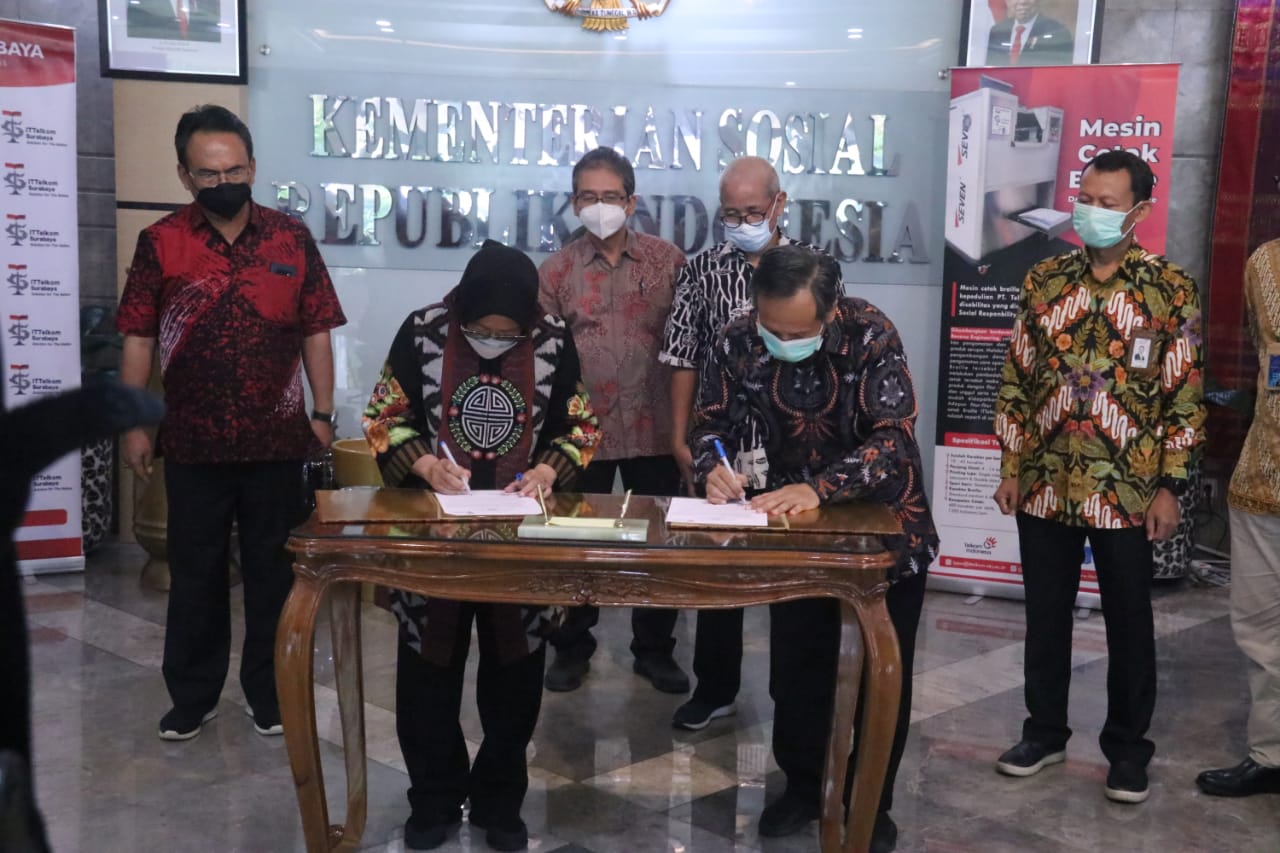Braille Printing Machine with Voice Feature to Accelerate Literacy for Persons with Disabilities

JAKARTA
(7 May 2021)
- Persons with disabilities are entitled to assistive devices according to the
needs and variety of disabilities. The Government and Regional Governments are
required to ensure the availability of assistive devices according to the needs
and types of disabilities as mandated by Law Number 8 of 2016 on Persons with
Disabilities.
Persons with visual
sensory disabilities as one of the types of disabilities due to visual impairment
really need literacy to maximize their language and communication skills.
Literacy is very
important in everyday life so that persons with disabilities can improve the
quality of life, mature skills, and build communication with the social world as
well as keep abreast of developments in knowledge and technology.
"We have to do our best
so that Persons with Disabilities can be independent because they have to
continue their lives, therefore we must seek literacy books that they can use
to realize their independence," said Social Minister Tri Rismaharini when
receiving assistance with a braille printing machine with a voice feature at the
Ministry of Social Affairs, Friday (7/5).
Social Minister Risma
received the assistance of a braille printing machine with voice features which
is a form of concern from PT. Telkom Indonesia for persons with disabilities
who are channeled in the CSR (Corporate Social Responsibility) program with the
Telkom Surabaya Institute of Technology.
Braille printing machines
with voice features are developed based on the Reverse Engineering process,
which is based on observations and studies on similar products. Through
research and development with observation procedures on how the braille
printing machine operates and by performing total surgery for the printing
press, products with better and superior features and spare parts that are
easily available in Indonesia are developed.
Braille is an embossed
letter in the form of a combination of 6 dots which allows Persons with
Disabilities to be able to feel the shapes of the 6 dots combination. How to
read braille letters is the same as reading Latin letters, which is from left
to right. On the other hand, if you want to write braille, people with visual
impairments will start from the right to the left.
Persons with Visual Sensory
Disabilities will find it difficult to learn if they use books that are
currently available. They might be able to hear, but it certainly wouldn't be
as complete if they could read independently.
"The books we have
prepared are books so that they can learn to be independent, for example how to
make cakes, how to make bread, how to raise livestock, how to garden, and so on.
We will distribute these literature books throughout Indonesia because not all
regions have special books for Persons with Visual Sensory Disabilities," explained
Risma.
The Ministry of Social
Affairs through the Braille Abiyoso Literacy Center in Cimahi is a national
reference center and a laboratory for developing national braille that aims to
meet the rights of Persons with Disabilities for information and knowledge so
that superior human resources are created.
The Center's productions
include Braille Books, Talk Books, Audio Mobile Library, and Digital Pen. In
addition, there is also a Tactual Map that is needed for Persons with
Disabilities to get spatial information with symbols that use simple visual
variables and are not too small in size.
"We will choose
books from the library of the Abiyoso Braille Literacy Center which are
directly beneficial to the lives of Persons with Disabilities," said
Risma.
The Head of IT Telkom
Surabaya, Tri Arief Sardjono, revealed that this braille machine is the 14th
machine-made and has additional voice features. "The machines before were
not there, this is based on input from persons with visual impairments since
2012. In 2014 we made the first prototyping, then every year it was assigned by
the Directorate of Special Education. In 2021, assisted by CDC PT Telkom to
submit this braille machine to the Ministry of Social Affairs, "explained
Tri Arif.
This braille machine has
a high speed of 1200 pages per hour, it is specifically for printing so it is
hoped that it can become a Book Publisher. The books currently available for
the development of skills of persons with visual impairments will be converted
into braille and then printed.
"Previously,
braille printing machines without voice features made it difficult for persons with
visual impairments to read the keys because there were 16 (sixteen) buttons. On
the voice feature braille printing machine, the first press immediately
provided the name and function information. When the keys are correct and
needed, they can directly press twice then the machine will run according to
its function," he continued.
The advantages of a
braille printing machine are voice features which have low power (energy
saving), local parts and components. The machine is easy to operate for
operators with visual impairments and is equipped with the latest software (up
to date) that is compatible with modern operating systems.
Technical specifications for braille printing machines with voice
features, namely the number of characters per line: 10-42 characters, sheet
length: 4-14 inches, printing type: single-sided / interpoint and double-sided,
line spacing: standard 5.08 mm, braille characters: standard medium 6 dots and
with a print speed of 400 characters per second, 1200 pages/hour.
Reading has very many benefits because by reading one will be able to
see the world from the window of knowledge of a book. For that, let us realize
an increase in human resources for Persons with Disabilities with accessibility
to literacy books that are useful for their lives.
 Bahasa
Bahasa
 English
English


